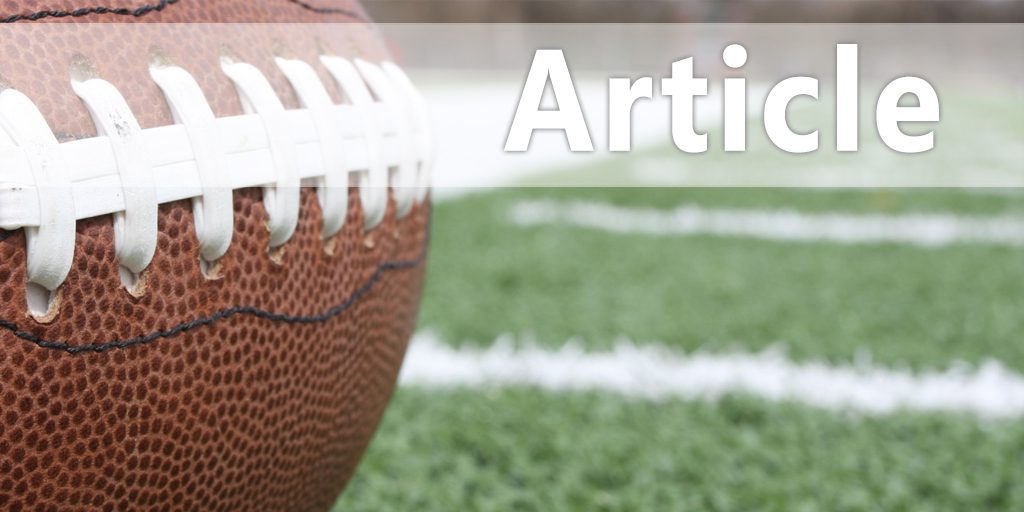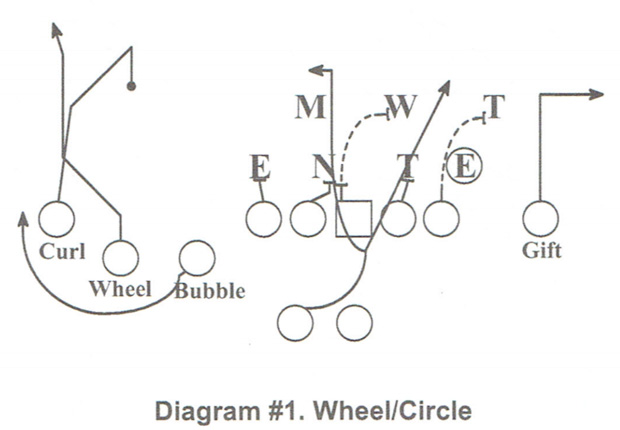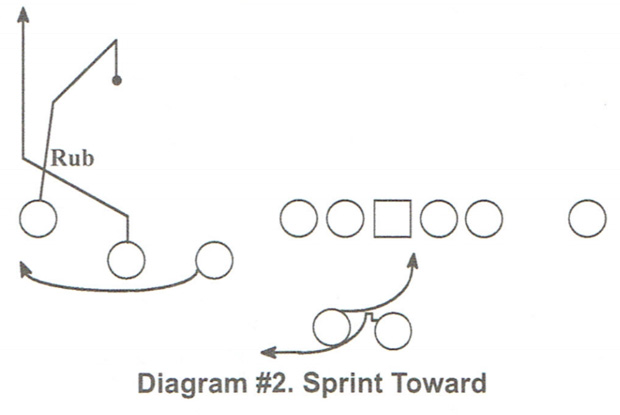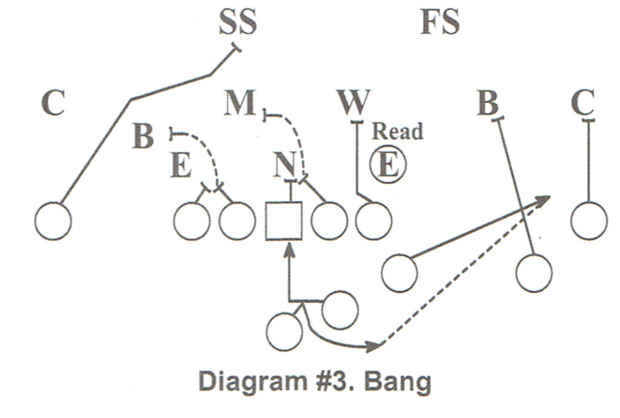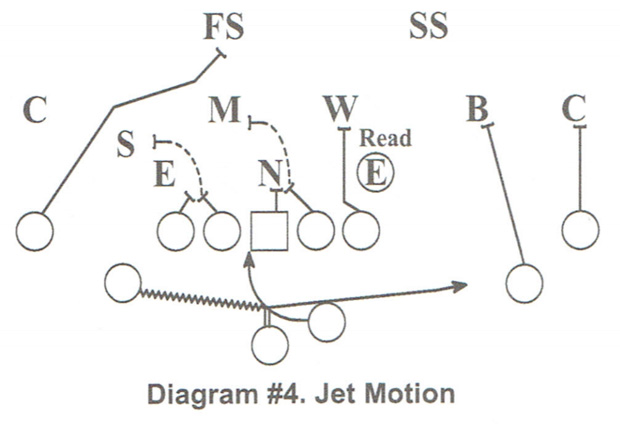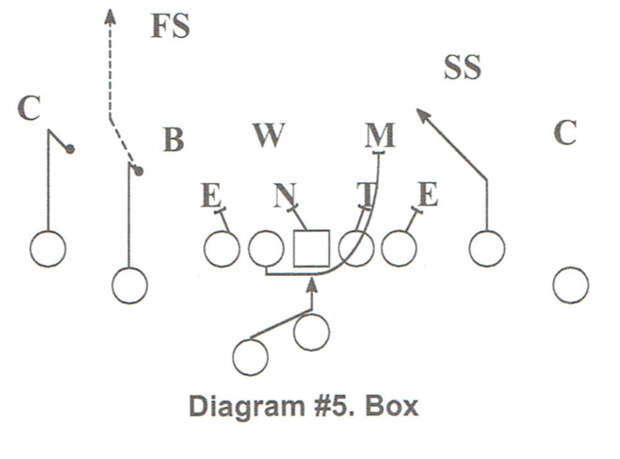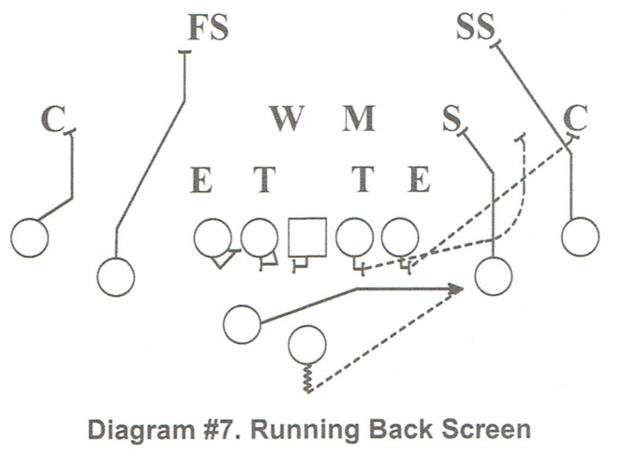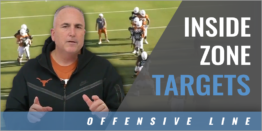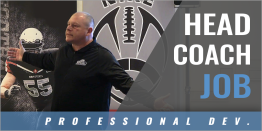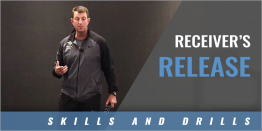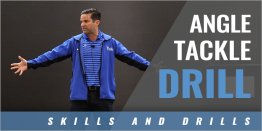| RPOs Via Zone and Power Plays |
| By: Ben Blackmon - Spanish Fort HS (AL)
Originally Published in: Nike 2017 Coach of the Year Clinics - by Earl Browning Provided by: Nike Coach of the Year Our high school is 6A in South Alabama close to the Gulf of Mexico. I have been the head coach for ten years and have been coaching for 16 years. I started coaching for my high school coach at Opelika High School as an assistant. I have had three stops and this is my third stop in coaching. Last year we were 15-0 and state champions in the 6A division in Alabama. The last two years we are 25-3. It is a really good school system to be in. The school has been there since 2006. In the ten years of existence, we have 16 state championship in all sports. It has been a very successful school. The success is not what I have done. They were successful before I got there and they will be successful after I leave. I am grateful to be there. I have been going to clinics for a long time. My dad runs the Nike Coach of the Year Clinic in Tunica, Mississippi. The difference between there and here is we have the clinic at the Gold Strike Casino. The coaches are out in the casino gambling instead of being in the room getting better. I learned about coaching at an early age. I heard Hayden Fry speak and that lit the fire I have for coaching. What he said really hit home with me. Types of Coaches "Those that want to be called a coach and those that want to coach." - Hayden Fry I was 16 years old and still playing high school football. I was sitting in the back of the room when he made that statement. I made up my mind that I wanted to coach and did not want to be one of those coaches that wanted to be called coach. I challenge all of you sitting in this room to take that to heart. I know there are coaches on a staff that just want the shirt and to be thought of as a football coach. They want to be on the sidelines but do not want to do the grunt work we all know is part of the job. The other side of that coin is the coach that is trying to soak up every bit of knowledge about the game. They are trying to do everything they can to make their players better and to advance the program. That is the coach you want to be. That hit home with me and gave me a perspective of what kind of coach I wanted to be. I want to share some coaching nuggets before I get into the topic. Coaching Nuggets • It is Jimmies and Joes and not X's and O's • Culture beats strategy • Character Ed - Dennis Parker (coachinctochangelives.col) • Coaching takes sacrifice - Trappist Monks • Books successful people read: ° Jon Gordon - Energy Bus. You Win the Locker Room First ° Richard Simmons - The True Measure of Man ° Todd Gongwer - Lead for God's Sake ° Urban Meyer - Above the Line ° Jeff Olson - The Slight Edge ° Jeff Tedford QB - Train Mentally with Checkers We all know it is not plays, but players. You have to get the ball to the players that can make plays. I challenge you to read a book written by a high school football coach in Texas titled "Culture Beats Strategy" by Randy Jackson. It is a great book for high school coaches to read. We got some great ideas that we are going to start at our school. Games are won by coaching not strategy. How do you get your kids to play hard? Fifteen years ago when I first went into coaching I came across a guy by the name of Dennis Parker. He wrote a book called "Coaching to Change Lives." He followed that up with a book about building character in your program. It is something that you do in 10-15 minutes a day about things that are going on in the world. Coaching is the last profession that teaches young boys to become men. We all know that coaching takes sacrifices. In particular it takes sacrifices with your family. However, do not let the coaching come before your family. Make sure there is a balance between those two things. I am a big reader and I believe if you are not reading, are not studying the game, and ways to improve, you are not doing the job. If you are not doing that you are falling behind. That is a list of books I have recently read and it will inspire you and make you more passionate about this great game. These are things I wanted to share with you today. If you take one of them and go do it, it will improve your coaching. The last one on that list is about Jeff Tedford training the quarterback using checkers. He painted a bunch of checkers different colors. He sat his quarterbacks down at a table and asked them questions about football. He made them use the checkers to align formations and run plays. He pitted the quarterbacks against one another in a checker game moving the checkers around in offensive plays. It is a novel idea and something you can use. Offensive Philosophy • Utilize core physical run game concepts to build an RPO • Use a simple terminology system to play fast • Vary tempo and personnel • Build pass game with concepts (2 and 3 man) add tags • Have a plan for game situations (man coverage, field position, down and distance) • Get the ball to players • Use motion, shifts, and trickery to hit explosive plays • The long ball beats the average man coverage, stretch the field vertically I want to get right into the topic. I want to show you some of the RPO's we work into our offensive game play. Using Concepts in Play Action • Combining run action protection and tagging concepts for drop back passing game • Double post, dig, out, cross. post-wheel, curl-flat, smash, and flood • Not RPO • Boot protection, counter protection, full slide zone protection We run our RPO's from our zone offense. Zone RPO's • Use the run pass option to give the quarterback the pen last • Pre and post snap reads • Quick screen tagged with run and sprint out • Used with up tempo offense allows you to play fast and have a viable option • Gift, run, option, pass When a bunch of coaches' get in a room talking football, the offensive coach will put something up and the defensive coach will diagram how they are going to stop it. Then the offensive coach says if you are going to do that we are going to do this. Then the defensive coach counters that. The coach with the pen last wins the argument. The RPO's give the quarterback the pen last. We play fast and tag the RPO's to our runs and sprint out passes. Running this offense gives you some viable options during a game. This first concept is called wheel/circle. (Diagram #1) When we first put this in there was a lot of moaning about linemen being down field.
It was about us releasing our offensive tackles on linebackers. If we ran inside zone right, we released the playside tackle to the linebacker and read the defensive end. The backside guard and center combination blocked on the 1-technique up to the inside linebacker. After all the moaning, the referees started to hone in on the tackle releasing down field and started to call us for it. We had to change what we were doing. Instead of reading the defensive end, we base blocked him with the offensive tackle and read the Mike linebacker to the trips side of the formation. We felt he could not play the inside zone play and stop the curl pattern behind him. If the Mike linebacker played the running play, we threw the curl/flat concept with the wheel to the trips side of the formation. That is how we changed to be able to throw the ball down field and not have linemen down field. We had a three man concept to the trips side of the formation. The outside receiver ran a curl route to the inside at 9-yards. The number-2 receiver ran a wheel route down the sideline and the number-3 receiver ran a bubble route. Whether to run the inside zone is a post snap decision made by the quarterback. When the quarterback comes to the line he has a pre-snap read. He reads the coverage to the single receiver side. If the receiver has free access to the field and a soft corner, we call that a "gift.' During the week we will decide what the gift pattern will be. It could be a speed out, hitch, or slant. Whatever the pattern we feel we can complete it for at least five yards. If the defender misses the tackle it could be a big play. We can run the read play with a 2 X 2 set or a tight end set. If we run with two receivers we run the curl/wheel combination. We still have the gift pattern if the quarterback feels the defense is giving us the free five yards. We can run the play from a closed formation with the tight end on the ball. If we run a trips formation and the defense plays us in a three over three coverage, we feel the box count will be in our favor to run the ball. If the quarterback is going to throw the ball on his post-snap read, he fakes the inside zone play. (Diagram #2) He runs his fake and rolls toward the trips side. As the number-1 and number-2 receivers leave the line of scrimmage, the number-2 receiver crosses behind the number-1 receiver, we get a natural rub. He knows the wheel route will be hard for the free safety to react to the throw.
The quarterback could run the ball from this play, but we did not want to get him hurt. He was not a 4.5 athlete and had some knee surgery. We triad to protect him by not calling a planned run. He ran about 4.9 but was an accurate passer and had good velocity on the ball. This is a great concept for us because we are an up tempo offense. We have one word that designates this play. Communication is quick and simple. If the defense moves the inside linebacker out of the box to the trips side, we run the zone play. That is in the pre-snap read of the quarterback. He can see the linebacker out of the box, which means we have a running advantage in the box. Another RPO, we run from this set is called "bang." (Diagram #3) We align the H-back, which is a tight end type of player, behind the playside tackle. We run the inside zone play with the interior blocking scheme. Against the 3-4 front, we are going to double team the nose to the backside linebacker. We release the playside tackle inside the read key to the playside linebacker. The backside guard and tackle block the defensive end and backside outside linebacker in combination.
This is a version of the bubble screen. However, since the screen receiver comes from an alignment in the backfield, the defense generally is not prepared for him to come from that alignment. We crack on the run force defender with the number-2 receiver to the playside. The number-1 receiver releases on the corner and stalk blocks him. We installed this early in the year and it became one of our best plays. The coaches kept telling me we should run this play more. That is a true fact, but more importantly we have to get the ball to the right players. We want to put the ball in the hands of a player that can make plays. A player that works well in open spaces. He has to make people miss on the tackle. You want to throw the ball to someone that will not stumble and fall down. He will score touchdowns because he is an athlete. We can vary the formation and run the same play out of a different variation. We can use motion to change the presentation of the play. We can use short motion from one side or we can use return motion. It is the same play from a different presentation. If the quarterback feels the H-back cannot get out on his pattern, he leaves the ball with the running back. The worst thing that can happen is no gain with the run. It is not a negative play. We use the play with jet motion by the H-back.
This presents a lot of movement problems for the defense. The jet motion is going one way, the run fake is going the other direction and the quarterback comes opposite the flow. We can run the jet sweep, but in this case it is a run fake. The timing must be right for the jet motion and running back. The quarterback does not fake to the motion back, but he crosses the snap from the center. He has to make sure he does not impede the snap. 2 X 2 RPO • 2 X 2 set • One word play calling • Boundary rules, field rules, box rules • 1 back power verses 5-man box • Soft corner hitch into the boundary • Man-free inside fade to the boundary • Cover-2 hard corner, slant to the field I stole this from my brother. He is at Auburn but was at Opelika High School in Alabama. This has to do with the box count. When we run it we call it boxing. The first thing the quarterback wants to do is count the box. If there are five defenders in the box, we run the one back power play. If there is a six man box, he look for a soft corner into the boundary. The hash marks on the field determine where the receiver goes and where the quarterback applies his rules. If there are six in the box and a soft corner into the boundary, the quarterback throws a 6-yard hitch to the boundary receiver. If he reads hard corner with two safeties deep, that is cover-2 for us. The quarterback throws the double slant into the field. With one safety, it is cover-3 or cover-1. In any case, the quarterback throw the fade to the inside receiver to the boundary. When we run the box play, we can run it either way.
We designate which way we are going to run so the guards knows who is pulling. This year we had one guard that did a better job of pulling than the other. We designated him as the puller on all one-back powers. It did not matter what hash the ball was on, he was the puller. The running back's landmark is at the butt of the center. He finds the gap on either side of the center. The center blocks back for the pulling guard. If there is six in the box, we are not running the ball. If the quarterback feels there is edge pressure coming, he gives the blitz call. That means there is no fake to the running back. The running back is going to take the edge pressure as part of the protection scheme. When the quarterback designates the play as a pass, he is going to throw the hitch into the boundary or the slant to the field. Box Rules • Five in the box, run one back power • Six in the box, soft corner hitch to the boundary • Six in the box, hard corner, one safety, fade to the inside receiver into the boundary • Six in the box, hard corner, two safeties, throw the slant into the field's number-2 receiver If we call the pass from the box, the guard still pulls for the linebacker. In our formations we always have the tight end to the double slant side and the H-back to the fade side. The two number-1 receivers do not flip/flop, they align right and left. The tight end and H-back flip from field side to boundary side. The outside receivers know if they are into the boundary, they are running the hitch route. If they are into the field, they run the double slant. The H-back into the boundary knows if there is a soft corner with six defenders in the box, the ball is coming to the outside receiver to his side. He is the protector of the throw. He is not going to get the ball but his pattern prevents the inside linebacker from trying to run under the hitch. If he reads the hard corner, he has to read how many safeties there are in the middle of the field. If there is one safety in the middle, he is going to get the ball. That means the corner is up and one safety tells him cover-1. He runs the fade against a strong safety or linebacker. If there is two safeties in the middle of the field, the ball is going to the field side with the double slant. 3 X 1 • One work call • Single receiver into the boundary hitch, verses man-coverage run a "go" • Box one-back power • Trips stick, seam, in route • Soft corner no hang defender, gift hitch • Hard corner work RPO off backside linebacker • Man-free or mini cover-2 throw seam to number-2 receiver • If nickel is head up the number-3 receiver, expect in-route to number-1 receiver We run this both ways. We call it East and West. East and West means right and left. We want the trips formation into the field side and the single receiver into the boundary. What we describe as a mini cover-2 has the curl/flat defenders with outside leverage on the receiver with the safeties inside leverage at 10-yards. When we run the play we want to count the box. (Diagram #6) However, we can run the power into a six man box. When we run the box play, the quarterback reads the Mike linebacker. If the Mike linebacker follows the pulling guard and plays the power, we throw the stick pattern to the number-3 receiver in the area vacated by the linebacker. It becomes a run or pass off the reaction of the Mike linebacker.
This is a good play for us. However, defenses will try to take that away with the strong safety. The linebacker plays the power and the safety drops down on the stick pattern. Or the linebacker covers the stick and the safety drops down in run support on the power. When we installed the play we read it exactly the way I just described. We were going to throw the gift pass first, and run the power second reading the linebacker and pulling or leaving the ball with the running back. When teams started to drop the safety down to cover the stick pattern, we starting throwing to the number-2 receiver running up the seam of the field. With the safety dropping the coverage was a cover-3 scheme. The number-3 receiver when he runs his stick route should know whether he is going to get the ball. He sees the same picture the quarterback sees. His job is to sit down in the open area away from the coverage. If the safety tries to rob the stick pattern, the quarterback goes up the field to the seam route by the number-2 receiver. The good thing is we can align in this formation and go fast. The communication does not slow us down and we will have a successful play if we execute. Running Back Screen • Simple screen to running back • Great verses man or zone • Good goal play and can be run from multiple formations • Playside receivers block the man inside of them • Playside tackle pulls for corner • Playside guard pulls for trash This play is very similar to the "bang" screen we run. It is a straight drop back play for the quarterback. This is the running back screen. (Diagram #7) The quarterback is in the shotgun and takes a three step drop. The running back comes across to the playside as if to block the edge. The playside tackle sits on the defensive end and lets him go. He releases inside the defensive end and comes flat down the line of scrimmage.
His job is to kick out the corner to that side. The wide outs to that side crack back on the first defender inside of them. The playside guard pulls for the outside linebacker and picks up the trash. He wants to pick off any linebacker inside that may have read the play. If the defense recognizes the play and covers the running back we have the ability to run a slip screen to the other side of the formation. Before I quit, I want to give a plug for wrestling. In south Alabama, we are into wrestling as a companion sport for football. Just below Montgomery, which is the capitol, there is a lot of support for the sport. I believe there is a lot of carry over value between wrestling and football. I know some people disagree because of the player losing weight to wrestle in a certain we I have a 9-year old son who wrestles. When you watch the films of him working out with the wrestling team, the take downs are about as good of display of form tackling you want to see. I think at an early age, wrestling teaches a lot of the same things we teach in football. In our off season we do a lot of wrestling drills that translate to football. It teaches leverage, balance, toughness, and conditioning as well. If you are ever in our neck of the woods, come by and spend some time with us. I hope you got something out of this session. If we can ever do anything for you let us know. I will be happy to share anything we have. I learned a long time ago about plagiarism. If you copy off more than one person, it is called research. I know that all coaches conduct a lot of research. I love the profession we are in. Thank you for your time. If I can do anything for you let me know. |
